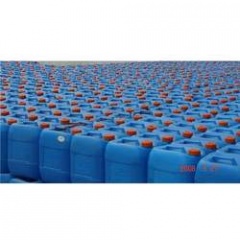Phenol
| Infobox on Phenol | |
|---|---|
| Example of Phenol |  |
| Facts | |
| Origin | - |
| Stowage factor (in m3/t) | 1,46 m3/t (drums) |
| Humidity / moisture | - |
| Ventilation | - |
| Risk factors | See text |
Phenol
Description
Phenol — also known as carbolic acid — is an aromatic organic compound with the formula C6H5OH. It is a white crystalline solid that is volatile. The molecule consists of a phenyl group (-C6H5) bonded to a hydroxyl group (-OH). It is mildly acidic, but requires careful handling due to its propensity to cause burns.
Phenol was first extracted from Coal Tar, but today is produced on a large scale (about 7 billion kg/year) from petroleum. It is an important industrial commodity as a precursor to many materials and useful compounds. Its major uses involve its conversion to plastics or related materials. Phenol and its chemical derivatives are key for building polycarbonates, epoxies, Bakelite, nylon, detergents, herbicides such as phenoxy herbicides, and numerous pharmaceutical drugs.
Although similar to alcohols, phenols have unique distinguishing properties. Unlike in alcohols where the hydroxyl group is bound to a saturated carbon atom, in phenols the hydroxyl group is attached to an unsaturated ring such as benzene or other arene ring. Consequently, phenols have greater acidity than alcohols due to stabilization of the conjugate base through resonance in the aromatic ring.
Application
Use: Phenolic resins, epoxy resins (bisphenol-A) nylon-6 (caprolactam), 2,4-D, selective solvent for refining Lubricating Oils, adipic acid, salicylic avid, phenolphthalein, pentachlorophenol, aceto-phenetidine, picric acid, germicidal paints, pharmaceuticals, laboratory reagent, dywed and indicators, slimidice, biocide, general disinfectant.
Hazard: Toxic by ingestion , inhalation and skin absorption; strong irritant to tissue
Shipment / Storage
Properties: White, crystalline mass which turns pink or red if not perfectly pure or if under influence of light; absorbs water from the air and liquefies; distinctive odour; sharp burning taste. When in very weak solution it has a sweetish taste.
Melting point 42,5-43°C
Boiling point 182°C
Flash point: 78°C
Autoignition temp. 715°C
Soluble in alcohol, water, ether, chloroform, glycerol, carbon disulphide, petrolatum, fixed or volatile oils, and alkalies. Combustible.
For overseas carriage aspects of Chemicals, the readers are recommended to acquire or have access to a good chemical dictionary, and a copy of the International Maritime Dangerous Goods (IMDG) Code, issued by the International Maritime Organisation. Also consult the applicable MSDS sheet.
Note:IMO quote (amongst others) the following on Phenol:
"Noxious liquid which if discharged into the sea would present a hazard to either marine resources or human health and therefore justify the application of anti-pollution measures", therefore due attention should be given to the packing instructions in the IMDG code when stuffing the container.
There are many Phenol, Phenolic and Phenoxy based chemicals that are used for many products e.g. pharmaceuticals, dyes and pesticides. Special attention should be given to many generic named pesticides that give no indication of Phenol in their name, e.g. Dicamba.
If containers are contaminated with Phenol or Phenoxy chemicals all dunnage and packing should be stripped out of the container and the container surface cleaned thoroughly to remove residual contamination. We understand this is not always successful and may result in these affected units being downgraded for Phenol and Phenoxy chemicals or to utilise for non-odour critical services.
See also: http://www.ukpandi.com/knowledge/article/262-09-02-phenol-phenolic-based-chemicals-1510/
http://www.ukpandi.com/knowledge/article/266-10-02-phenol-phenolic-based-chemicals-1514/
Risk factors
Toxic by ingestion, inhalation and skin absorption; strong irritant to tissue. TLV: 5 ppm in air.











